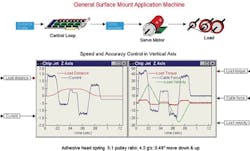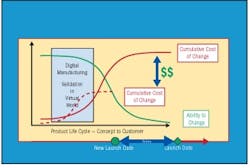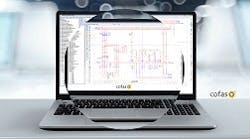When a robot slammed into a slide-mounted weld gun at Citation Global Manufacturing a few years ago, the now-defunct company’s mechanical engineer stared at the two devices for a few seconds, and said, “Well, that didn’t happen on paper.”The weld gun hadn’t completely returned to its home position before the robot tried to occupy the workspace, and so the robot didn’t have enough clearance to avoid a collision. Citation’s staff fixed their machine on the plant floor, but the real-world accident and resulting downtime could have been avoided if the weld gun and robot had been running earlier in a 3-D simulation.
Jim Montague is the executive editor for Control. Email him at [email protected].
“A good simulation and validation software could have flushed out this problem ahead of time, and determined if the right switch was in the logic, or if a cycle time needed to be increased,” says Mark Taylor, Global’s controls engineering manager at the time. “However, if all these parameters, including switches, wiring, and cycle times, aren’t accurately entered into a simulation, then users can have problems and downtime. Still, users need to know that they can use simulation to design problems out of their processes by using dynamic data flows that make their simulations as real time as possible.”
So, just when does a picture become real? At what point does a simulation become an operation? Logically, like judging people by their actions, an image might best be defined as real when it can do what real objects do. When its presence is felt and it can be used to act on its surroundings, it can claim membership in the real world.
Pictures are real enough, of course, but a cave painting can’t hunt an animal, a blueprint isn’t a roof over your head, and the coolest, most-detailed, highest-resolution CAD/CAM drawing can’t independently address an individual machine’s unique quirks and environmental wrinkles, just as a simulation can’t operate that machine’s overall application. Or can it?
Simulation is pushing ever further into the real world, and several software-based design tools have grown sophisticated enough to not only mimic very complex devices, but also incorporate unique test, PLC, and other data from individual applications before building the machines they need. Pre-configuration and pre-testing are being joined by “pre-operation.”
In fact, CAD has long had the ability to add application-specific data, but the level of programming required grows and quickly becomes prohibitive, as physical forces such as weight and friction are simulated. However, simulation is pulled into reality anyway. As it performs more prototyping duties, more bugs can be worked out ahead of time and more can be saved on modifications that otherwise would have to be done during or after construction. As usual, the trick is simplifying the programming, while maintaining enough computing power to achieve useful simulations.
For instance, when designing its new General Surface Mount (GSM1) pick-and-place machine for printed circuit boards, Universal Instruments in Binghamton, N.Y., needed to improve the assembly system’s head and Z-axis, and design mechanical elements that would support that head’s acceleration and deceleration rates, including a 10-ms settling time. Universal’s motion control engineer, Jim York, says his company used simulation software to wire together pre-defined function blocks onscreen, and model properties specific to GSM1’s servo drive, such as position, velocity, and current control, as well as all parameters affecting cable tension, including acceleration and deceleration rates, load mass, spring rate, and friction (See Figure 1).
FIGURE 1: VIRTUAL OBJECT WIRING
“Component operating parameters were entered directly to the appropriate blocks through pop-up dialog boxes,” says York. “During simulation, we viewed the dynamics of the cable’s tension in plots and real-time graphs. As we entered known values for acceleration, deceleration, and mass, their effect on the tension could be monitored immediately. This allowed us to adjust the spring rate so the tension was positive at all times.
“Simulation allowed us to design GSM1 much faster than if we had assembled a breadboard and performed physical testing. Also, the GSM1 model provided a high accuracy, allowing us to examine signals that would have been too difficult to monitor in a breadboard. Because we could view the entire dynamic picture of the mechanical load, we designed the components to properly support the acceleration and deceleration rates of the vertical axis, ensuring tight control of the load while it moved up and down. And, by validating the design through simulation, we could identify the correct components before building the prototype, significantly shortening the design cycle.”
Basic Needs
The most popular use for simulations in machine-tool controls is verifying part programs, program execution, or data collection validation in machine metrology applications. Simulators also test integration of new electronic and peripheral systems before integrating them on actual machine tools.
For example, Wärtsilä Corp. previously used manual C-code to create the embedded control systems for the common-rail, electronically fuel-injected, oil-fired diesel units it makes for marine propulsion and power-generating applications, but the old code prevented its engineering teams from developing clear specifications and communicating.
“C-based development also had become extremely difficult and required too many engine tests,” says Ari Saikkonen, Wärtsilä’s automation expert. “We needed an integrated, dynamic simulation for testing our application against a detailed software model, and one with enough accuracy to ensure that when the application first runs on a real engine there would be very few issues.”
Wärtsilä decided to use The Math Works’ Simulink software to design and simulate its system models and Real-Time Workshop embedded-coder software to generate production code from the models automatically. The company’s engineers used these tools to represent complex functions and algorithms with hierarchical block diagrams and state machines. They further used Simulink to model control law functions such as PID controls, fuel limiters, and feed-forward control. Wärtsilä also created a component library to help its staff assemble and manage large applications, which also means iterations are easier to execute because the design is clearer and matches the implementation.
“The automatically generated code was better than hand code for RAM, ROM, and execution speed,” adds Saikkonen. “We estimate we’ve reduced code size up to 30%, and reduced CPU execution time by nearly 20%. The higher abstraction, improved structure, and automatic production code has made us two to three times more productive.”
Because modeling a machine tool’s control system with simulation software is so complex, users historically built standalone control system mock-ups that weren’t attached to actual machine tools. This allowed them to test control systems with less risk and difficulty, and these simulators have become increasingly software-based, especially in the past two or three years. In fact, simulation software now can model the exact operation of a CNC system.
“There’s no reason to be scared of simulation anymore,” says Dean Streck, COO of VI Engineerng, a system integrator in Farmington Hill, Mich. “It used to be complex, but it’s far easier and less costly to use now than it was even five years ago.”
For example, GE Fanuc’s simulation software for its 30i control systems can duplicate everything that happens in a real machine-tool control system. Its model examines all the programming in the control system’s parts program, which is its recipe for producing a product, and in its ladder program, which is its interface to the machine. This allows the model to test both programs, develop and test the machine’s application, and enable better training, too. “Simulating the parts programming and the actual motions that happen inside a machine tool enhances training because you can see what’s going on inside the machine, and do it on a desktop PC without the actual machine,” says Gary Highley, GE Fanuc’s CNC product manager. “This allows users to see what tool is in the simulated chuck, make tool changes, and watch it make virtual cuts. This means users can do machine-tool training without having to install a $100,000 machine.”
Good Data = Good Simulation
Similar to all control and automation disciplines and many other fields, truly useful and individualized simulation depends on the quality of data coming in.
“Simulation is at the point that we can completely model the non-linearity, or real-world presence, of any system, and tune models with test data from users’ own applications,” says Tony Lennon, The Math Works’ marketing manager. “However, simulation still depends on how well the user knows their application, and how well they feed the design and model. This type of model-based design enables users to develop a simulation using executable specifications, which then can be used to create their resulting control system at the same time. The Math Works’ Simulink software also allows users to work in C-code, which can be run in real-time applications.”
Everyone in simulation knows about garbage in/garbage out. “The question is how do you get good data, and do you manage it as a byproduct of your design environment, or as core to your design process?” says Taylor, who is now vice president and general manager of ePlan Software and Services. “Many people still manually gather electrical drawings and schematics in CAD, and add to the CAD environment from their databases, which can cause continuity problems. A true database environment makes it easier to manipulate data, and transfer it to a simulation. So, instead of using existing drawings to generate a simulation, we use dynamic, accurate system data to generate the drawings for simulation tools, and eliminate garbage in/garbage out.”
Taylor adds that poor quality data is a big reason that simulation didn’t have more momentum in the past. “The data coming into traditional systems wasn’t consistent before, and this resulted in data sets that weren’t representative enough for useful simulation,” add Taylor. “Now, users are beginning to understand and migrate to doing data-based engineering, instead of the usual CAD engineering.”
Recreating Physics
To be useful to real-world machines and applications before they’re built and installed, simulations must also recreate the physical forces that will act on those devices, as well as the forces they’ll dole out when they’re operating. “Simulation all boils down to math,” says Jim Webb, Visual Solution’s sale manager. “Simulations are built from mathematical first principles that duplicate items such as springs. They interface with the real world by validating to make sure the model accurately reflects reality. For instance, if you tweak a simulated process and its value goes from 10 to 12, then you know it’s correct if it’s tweaked in the real world and its value also goes from 10 to 12. It’s similar to calibrating any instrument. And, once you’re confident in your model, you can cut the cord to the plant, and run all kinds of good or bad what-ifs, and see how your controller responds.”
Mark Hoffman, president of Automation and Control Concepts Inc., a system integrator in St. Louis, Mo., explains that, “The simulation world is basically perfect, and so we have to introduce the faults and responses that simulated devices are likely to encounter in the real world.”
Dan Rackleft, of Dextus, a new consulting division of Schneider Electric, says developers start with 3-D design geometries, add kinematic capabilities to let the images move, and then use software tools to emulate the mass, speed, force, friction, torque, air pressure, and all other required aspects that a device manifests in the real world. For instance, Dextus is using ePlan’s simulation package to help verify and control machine components’ cycle times, and avoid potential collisions in their applications. Logically, as software improves and computing power increases, developers plan to emulate increasingly complex devices, control systems, machines, production lines, and entire facilities.
“People have to realize that these aren’t cartoons. These are simulations, but they can be trusted and used just like real systems,” says Robert Axtman, Delmia’s worldwide marketing executive director. “You can layout cycle times and material flows, and optimize your manufacturing system before building and installing it. These days we can get 80-90% of a system’s functionality checked out ahead of time, which can help users meet their own start-production targets, and reduce costs." (See Figure 2)
FIGURE 2: REAL SAVINGSElectrical, Mechanical Collaboration
Besides improving real machines, simulation tools are giving engineers and companies new chances to cooperate—even though many appear reluctant to do it.
“Full virtual testing of operating machines is possible, and there’s every reason to do it, but it requires a cultural change, too,” says Sujit Jain, Solidworks’ vice president of analysis. “For instance, people are doing virtual testing at the parts stage, rather than at the assembly stage, and designers have been compiling this testing information for two or three years. However, the resulting data was only available previously to analysts, and there wasn’t even a workflow to get it out to everyone else. This meant designers had to go back to the analysts, and then they might hope to get some data tossed back over the wall to them.”
Jain adds that Japan-based Sumitomo had a similar analyst-based infrastructure with a six-to-eight-week turnaround on submitted data, but its designers used Solidworks’ software to analyze their own basic machine function data in one week.
“Even if you have a virtual design, you may then have to add ladder logic to control the PLC, or add a PLC algorithm to the Solidworks design,” say Jain. “There still are barriers to using ladder logic at the PLC level because events there happen so fast. Where is the virtual PLC that can connect ladder logic to the virtual machine?”
Solidworks also is working with National Instruments on how to present Solidworks’ drive assembly simulations via NI’s LabView software. Jain adds these efforts still are experimental, however, and any solutions are still a couple of years from availability.
Despite the simulation technical tools available to them, many engineers rarely communicate with potentially helpful colleagues. “The question now is how to marry electrical and mechanical engineers when they hardly talk to each other,” says Jain. “Using simulation to collaborate sounds great, but there are still many hurdles and cultural issues to overcome.” If they do start taking, he adds they can see exploded views of their applications by using Solidworks’ Cosmos software.
“Typically, it’s only when the mechanical, electrical, and robotics guys are all done—and the physical device is assembled on the plant floor—that the controls guys finally get to come in and debug everything. That’s just too late,” says Rackleft. “This is why we want our Virtual Integration and Validation program to mimic all of these physical devices and assemblies, so control engineers can debug and validate PLCs, HMIs, and other machine components in a virtual environment.”
In fact, Dextus is using an OPC server to link some 3-D model objects, such as pushbuttons, with real PLCs and HMIs.
This new collaboration is, in turn, founded on the accurate reflection of their real-world counterparts that many simulation tools provide. “If a simulation has a 10 sec cycle time, then the real device will have a 10 sec cycle time,” says Rackleft. “If you’ve got 20 robots in a system, for example, this accuracy is what lets you think through your process, account for the time each device needs to do its job, test ahead, see errors before installation, and validate a control system before building it.”
Because simulation generally seeks to get rid of disparities between disciplines, Taylor adds that European simulation developers and suppliers are pursuing “functional engineering,” which organizes simulation by operating functions, rather than by engineering disciplines. “We’re trying to reach the point of having no difference between what it takes to build a 3-D model and what it takes to have a digital prototype, so we’ll basically be able to turn on a machine while we’re still inside the computer,” says Andrew Anagnost, Autodesk’s CAD/CAE products director. “This reduces design iterations, and takes the burden off the user because it’s the machine’s functional requirements that drive the design geometries.”
These current and upcoming efficiencies show that simulation can help preserve perhaps the most important images of all—dead presidents on the cash that goes right back onto users’ bottom lines.
Simulation Applications
Users report that Visual Solutions’ VisSim software has helped them in many ways. Here are some of the most significant examples:
- Mohan Thiagarajah, an applications consultant at Honeywell UK, used VisSim to simulate two electric motors, four Rolls-Royce Avon gas turbines, 10 compressors, 10 recycle valves, and 10 flow measurement elements on a 100,000-barrels-per-day platform at the Amoco Valhall oilfield in the North Sea. All the models were linked to board-level I/O cards via VisSim, which allowed Honeywell to test the all controller/control modes simultaneously. “We were able to start-up any or all of the turbo-compressors, run them in series/parallel load-sharing configurations, and shut them down at will. The control system became operational at the press of the button,” says Thiagarajah. “This model building exercise took two months of engineering, but Amoco’s project manager, Karl Ole Stones, was convinced that it saved 21 days of off-shore commissioning.”
- William Erickson, an engineer in Rexroth’s Indramat division, employed VisSim to convince a motor-supplier client to use frameless motor technology. “VisSim’s interactive environment enabled me to easily generate dynamic graphs of motor torque over time, and showed that a frameless motor could perform the required bandwidth,” says Erickson. “Because I was able to guarantee that the motor configuration would meet the customer’s specifications, his management approved the design. I also was able to test the machine-motor configuration in the lab, and completed testing in a few hours.” The frameless motor allowed the motor supplier to build a machine with a smaller volume, stiffer frameless motor yields that improved product quality, and more flexible configuring shafting and bearing structure options.
- Instron and LightSpeed Simulation Systems jointly used VisSim to develop and test the motion platform for their new Argo II entertainment motion simulator. This platform consists of an advanced servo-hydraulic motion system with 3º of freedom and more than 2 Gs of vertical acceleration to provide the unit’s heaves, rolls, and pitches. Albert Barrett, Instron’s principal engineer, says VisSim’s non-linear functions and its graphical interface allowed him to design the motion platform using a classic control method. To obtain non-linear data, Barrett connected the motion controller to a PC with an I/O board, so when the controller received a signal, it calculated the PID error control loop, and sent a valve drive signal back to the software. Barrett used this empirical data to complete his model in VisSim, where dynamic graphs displayed motor current, position, and velocity behavior. So, when he interactively “tweaked” system values, the effects of the changes were immediately reflected in the graphs. “One of our key discoveries was that the bandwidth of the proportional valves was too low,” he explains. “When we replaced the valves with ones having a wider bandwidth, we saw the improvement in the system.”






